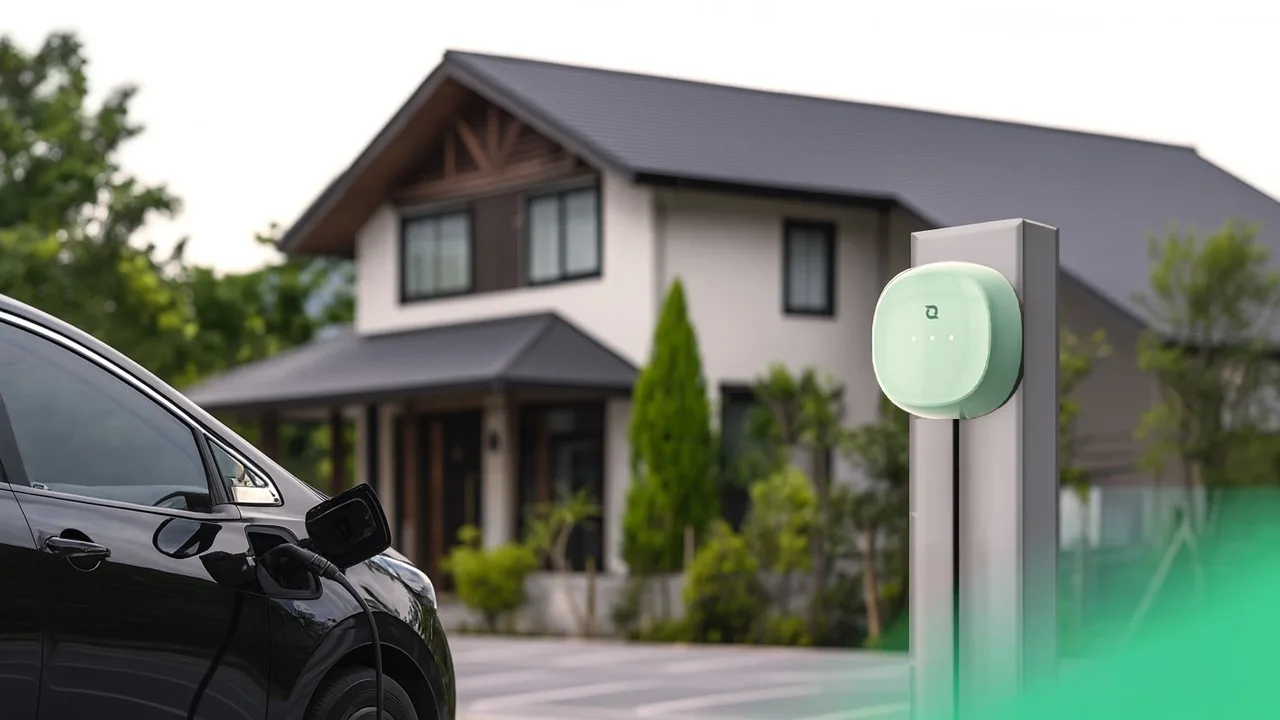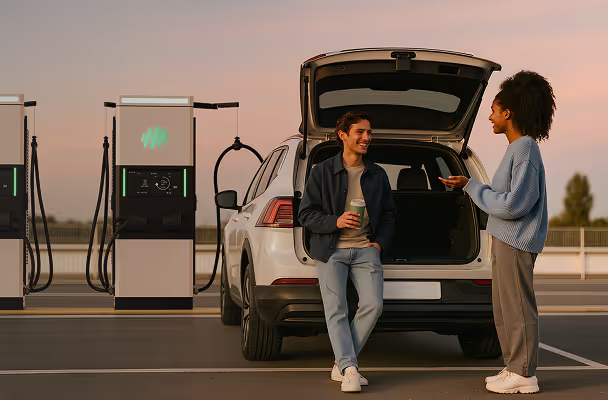4 ways in which Smart EV Owners beat Range Anxiety

Have you ever been driving your EV and suddenly found yourself wondering, “Will I make it to the next charger?” That quiet worry is something almost every EV owner experiences – it’s called range anxiety. Even though India’s charging network is expanding rapidly, the reality is that public chargers can still be unpredictable. You might arrive to find the charger busy, out of order, or simply not conveniently located on your route.
Sounds familiar? You’re not alone. This uncertainty can make trips stressful, whether it’s a daily commute or a longer journey. But here’s the good news: many diligent EV owners have found ways to beat this anxiety.
In our latest blog, we dive into practical, proven strategies that turn range anxiety into charging confidence. From smart route planning with backup chargers in mind, to building personal charging setups at offices, second homes, or even rental properties, these owners take control of their EV experience rather than leaving it to chance.
1. Master the Art of Route Planning
Seasoned EV owners carefully plan their routes using charging apps that help them find stations, check real-time availability, and read feedback from other drivers. This way, they ensure chargers are working and avoid unpleasant surprises. They always identify backup options for every planned stop, so if one charger is unavailable, they have alternatives ready. To stay connected even in areas with poor signal, they download maps for offline use, keeping their journey smooth and stress-free.
2. Build Your Personal Charging Network
This is where smart EV owners really stand out. They treat charging not as a convenience, but as a network they can control strategically placing chargers in locations they control: personal offices, farmhouses, second homes and even rental properties.
At first glance, setting up your own charging infrastructure might seem like a hassle. It can require an upfront investment, time for installation, and some planning. It may not even appear to be the most cost-effective choice when public chargers are increasingly available. But in the long run, it can save you money, reduce daily stress, and give you unmatched control over your EV experience.
With a personal charging setup, you decide when and how you charge, avoiding peak pricing at public stations. For instance, home charging during off-peak hours can cut electricity costs significantly compared to fast chargers on highways or commercial hubs. It also means you can start every day with a full battery, eliminating the need for detours or waiting in queues.
Beyond convenience, it protects you from unforeseen circumstances. Imagine returning late at night to find your nearest public charger out of service or occupied. Your own charger ensures you are never left stranded. Over time, this reliability can reduce range anxiety and make EV ownership feel effortless.
It is also a future-proof choice. As EV adoption grows, public charging demand will rise, potentially leading to longer wait times and higher costs. Having your own network shields you from such pressures. For households with multiple EVs, it can even become a shared resource, maximising utility while keeping operational costs low.
In short, while the initial step may feel like a bigger commitment than relying solely on public infrastructure, it pays for itself in financial savings, peace of mind, and the comfort of always being ready to drive. Investing in your own charging network is not just a matter of convenience, it is a smarter, more sustainable way to enjoy electric mobility for years to come.
3. Adopt a Battery Health & Efficiency Routine
Bigger batteries don’t automatically mean more stress-free driving. Battery management does. Keep your charge between 20% and 80% for daily use to extend battery life and reduce degradation. Top up overnight before office commutes, and avoid starting long trips without at least an 80% charge. Use Eco Mode and moderate acceleration to squeeze 10 to 15% more range out of every trip. Maximise regenerative braking in city conditions and you’ll be surprised how much range it adds over time.
4. Always Carry a Portable Charger and Prepare for the Unexpected
Carrying a portable charger is one of the smartest ways to stay ready for any situation on the road. In places without regular charging points like remote highways, hill villages, or quiet resorts, a portable charger lets you plug into any standard socket and gain enough power to reach the nearest station. Alongside this, smart EV owners keep roadside assistance contacts handy and carry a power bank to keep their phones charged since a dead phone during an emergency can create extra trouble. In colder weather, they precondition the cabin while plugged in to conserve battery power. Being prepared this way takes the stress out of unexpected detours, charger outages, or bad weather, making every journey more relaxed and worry free.
Range anxiety thrives on uncertainty. Once you have charging confidence, you stop thinking “Will I make it?” and start thinking “I have multiple ways to make it.”
The smartest EV owners don’t just drive — they design their charging life. By blending public infrastructure with private charging points, carrying portable solutions, and adopting efficiency habits, they make every journey — whether a 15 km commute or a 1,500 km road trip — predictable, comfortable, and worry-free.
Explore how we’re preparing for what’s next →here
FAQs:
1.What is an EV's range anxiety?
The worry that an electric vehicle's (EV) battery will die before it reaches its destination or a charging station is known as range anxiety. One of the most frequent worries among new EV owners is this one, which is frequently brought on by inadequate infrastructure for charging, a lack of knowledge about the availability of chargers, or ignorance of the vehicle's true range. Range anxiety can be considerably decreased and EV driving made stress-free by installing a home or workplace charger, using charging apps, and planning routes with backup charges.
2. Is it expensive to install EV chargers at home or other properties?
Installing an EV charger at home or other properties does involve an upfront cost, typically ranging from ₹30,000 to ₹80,000 depending on the charger’s capacity and installation complexity. However, research shows that home charging is significantly cheaper than using public fast chargers.
3. How can I plan my EV trips to avoid charging issues?
Use route planning tools (like google maps and chargin) that show available chargers along your path and their current status. Always identify backup charging points and download offline maps to navigate areas with poor signal. DO not forget to read reviews which will make you aware of the condition of charger.
4. Does charging at home affect my electricity bill significantly?
Charging at home will increase your electricity usage, but it is generally more cost-effective than using public fast chargers. For example, home electricity rates typically range from ₹5 to ₹8 per kWh depending on your state and tariff plan. In contrast, public DC fast chargers can cost anywhere between ₹15 and ₹25 per kWh. You can save even more by charging during off-peak hours when home electricity rates are lower, making home charging the most economical and convenient option for daily use.
5. What should I do if I encounter a broken or busy charger?
Always have backup chargers planned along your route. Carrying a portable charger and having roadside assistance contacts ready can also help you manage such situations smoothly.
Frequently Asked Questions
Lorem ipsum dolor sit amet, consectetur adipiscing elit, sed do eiusmod tempor incididunt ut labore et dolore magna aliqua. Ut enim ad minim veniam, quis nostrud exercitation ullamco laboris nisi ut aliquip ex ea commodo consequat. Duis aute irure dolor in reprehenderit in voluptate velit esse.
Lorem ipsum dolor sit amet, consectetur adipiscing elit, sed do eiusmod tempor incididunt ut labore et dolore magna aliqua. Ut enim ad minim veniam, quis nostrud exercitation ullamco laboris nisi ut aliquip ex ea commodo consequat. Duis aute irure dolor in reprehenderit in voluptate velit esse.
Lorem ipsum dolor sit amet, consectetur adipiscing elit, sed do eiusmod tempor incididunt ut labore et dolore magna aliqua. Ut enim ad minim veniam, quis nostrud exercitation ullamco laboris nisi ut aliquip ex ea commodo consequat. Duis aute irure dolor in reprehenderit in voluptate velit esse.
Lorem ipsum dolor sit amet, consectetur adipiscing elit, sed do eiusmod tempor incididunt ut labore et dolore magna aliqua. Ut enim ad minim veniam, quis nostrud exercitation ullamco laboris nisi ut aliquip ex ea commodo consequat. Duis aute irure dolor in reprehenderit in voluptate velit esse.
Lorem ipsum dolor sit amet, consectetur adipiscing elit, sed do eiusmod tempor incididunt ut labore et dolore magna aliqua. Ut enim ad minim veniam, quis nostrud exercitation ullamco laboris nisi ut aliquip ex ea commodo consequat. Duis aute irure dolor in reprehenderit in voluptate velit esse.




